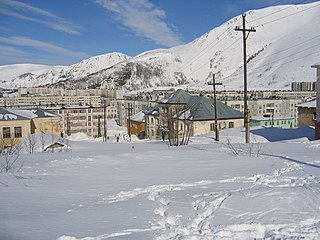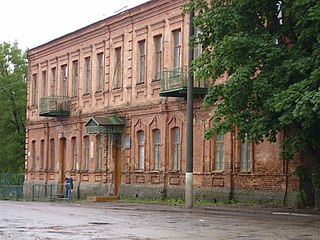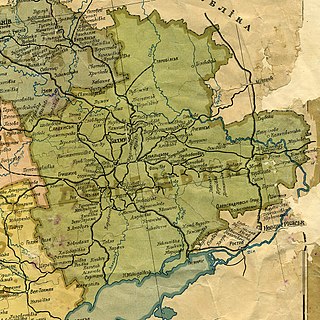Kuban Black Sea Oblast (Russian : Куба́но-Черномо́рская о́бласть) was an administrative division (an oblast ) of the Russian Soviet Federative Socialist Republic which existed in 1920–1924.

Russian is an East Slavic language, which is official in the Russian Federation, Belarus, Kazakhstan and Kyrgyzstan, as well as being widely used throughout Eastern Europe, the Baltic states, the Caucasus and Central Asia. It was the de facto language of the Soviet Union until its dissolution on 25 December 1991. Although nearly three decades have passed since the breakup of the Soviet Union, Russian is used in official capacity or in public life in all the post-Soviet nation-states, as well as in Israel and Mongolia.
An oblast is a type of administrative division of Belarus, Bulgaria, Kazakhstan, Kyrgyzstan, Russia, Ukraine, and the former Soviet Union and Kingdom of Yugoslavia.

The Russian Soviet Federative Socialist Republic, previously known as the Russian Soviet Republic and the Russian Socialist Federative Soviet Republic, as well as being unofficially known as the Russian Federation, Soviet Russia, or simply Russia, was an independent state from 1917 to 1922, and afterwards the largest, most populous and most economically developed of the 15 Soviet socialist republics of the Soviet Union (USSR) from 1922 to 1990, then a sovereign part of the Soviet Union with priority of Russian laws over Union-level legislation in 1990 and 1991, during the last two years of the existence of the USSR. The Russian Republic comprised sixteen smaller constituent units of autonomous republics, five autonomous oblasts, ten autonomous okrugs, six krais and forty oblasts. Russians formed the largest ethnic group. The capital of the Russian SFSR was Moscow and the other major urban centers included Leningrad, Novosibirsk, Yekaterinburg, Nizhny Novgorod and Samara.
When Soviet power was re-established in the region of Kuban in March 1920, the executive power in the region formally belonged to the Provisional Kuban Executive Committee, established on March 18, 1920. On March 27, 1920, the committee's duties were transferred to the Kuban Oblast Revolutionary Committee, which supervised the territories of Kuban Oblast and Black Sea Governorate. On March 29, 1920, the committee was renamed "Kuban Black Sea Revolutionary Committee", and as a result of that the joint territory of Kuban Oblast and Black Sea Governorate started to be referred to as "Kuban Black Sea Oblast", after the committee's new name, although no formal decrees establishing a new administrative unit had been passed. The new oblast was not officially recognized until December 7, 1920. [1]
Soviets were political organizations and governmental bodies, primarily associated with the Russian Revolutions and the history of the Soviet Union, and which gave the name to the latter state.
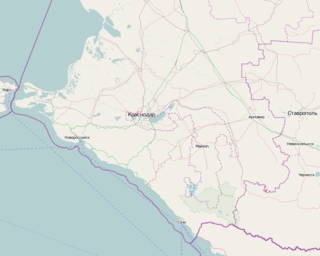
Kuban is a geographic region of Southern Russia surrounding the Kuban River, on the Black Sea between the Don Steppe, the Volga Delta and the Caucasus, and separated from the Crimean Peninsula to the west by the Kerch Strait. Krasnodar Krai is often referred to as "Kuban", both officially and unofficially, although the term is not exclusive to the krai and accommodates the republics of Adygea, Karachay-Cherkessia, and parts of Stavropol Krai.
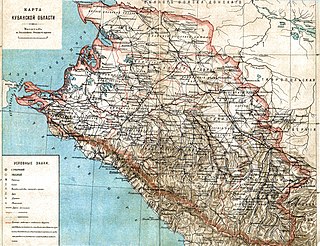
The Kuban Oblast was an oblast (province) of the Caucasus Viceroyalty of the Russian Empire. It roughly corresponded to most of the Kuban and Circassia regions. It was created in 1860 out of Kuban Cossack territories that had once been part of the Crimean Khanate and the land of the Circassians. It was dissolved upon the assumption of supreme authority by the Kuban Rada in 1917 and the independence of the Kuban People's Republic in 1918.
On August 7, 1920, the jurisdiction over Kuban Black Sea Oblast, as well as over several neighboring territories, was transferred to the Revolutionary Soviet of the South-East Russian Labor Army. Although the Soviet itself ceased to exist in the 1921, the territory of its jurisdiction continued to be informally known as "South-East" (sometimes also as "South-Eastern Krai" or "South-Eastern Oblast").

The South-East, also referred to as South-Eastern Krai and South-Eastern Oblast was a territory, and later an administrative division, of the Russian Soviet Federative Socialist Republic (RSFSR) which existed in 1920-1924.
Kuban Black Sea Oblast ceased to exist on February 13, 1924, when it was re-organized into four okrugs of South-Eastern Oblast (Krai).
Okrug is an administrative division of some Slavic states. The word "okrug" is a loanword in English, but it is nevertheless often translated as "area", "district", or "region".


